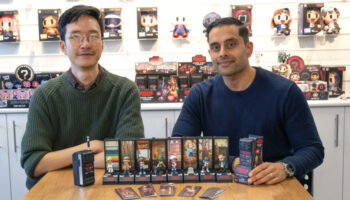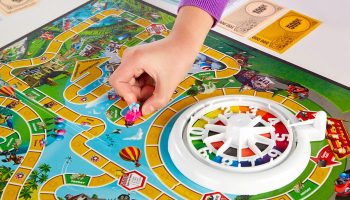Toyish’s Assaf Eshet on combining the power of magnets, the magic of origami and the ease of building blocks in Clixo

Assaf Eshet is a design lecturer at the University of Pennsylvania, and the founder and CEO of Toyish Labs, an award winning toy studio that looks to transform the pursuit of perfection into a joyful quest of exploration, curiosity, and learning.
This year has seen the firm debut Clixo, a brand new open-ended play system that combines the magic of origami, the ease of building blocks, and the power of magnets.
We caught up with Assaf to learn about how his career as an educator has informed his work with Toyish Labs, why he feels perfectionism holds back creativity and where the idea for Clixo first came from.

Hi Assaf; so before we get onto Toyish, a quick browse at your Linkedin shows you’re predominately a teacher of toy design. Did coming into the industry through education help shape what you’re doing now with Toyish Labs?
I think my Israeli mind has something to do with it because a lot of designers in Israel are drawn to toy invention. It’s in the DNA; we like to solve problems, we like to ask questions and find our own solutions for things. It’s in our nature and for me, it wasn’t a rational decision where I said “I’m going to be a toy designer”.
I actually collected toys for many years – all kinds of toys and designer toys – but I never thought about being a toy designer. I think it happens to many creators – it’s destiny, where one good client that leads to another, and another…
Absolutely; and who was the client that started the chain for you?
I worked for a client called Tiny Love and did some projects that let me tap into a huge love for inventing and to explore kids’ imaginations. It opened an ocean of things that I could play with and tap into, whereas when I was designing for adults, there was a big focus on function and criticism and comparison. It made me see humans as spoiled creatures in a way! But when I design for kids, I tap into a different realm of creativity and imagination; there’s a real freedom of creation.
And Tiny Love led to more toy connections?
Yes; after a few years working with some local clients and Tiny Love, I went to some toy fairs and eventually got a chance to work with Fisher-Price at Mattel. I created a lot of things for them, consulting in some capacity and then I started working with other companies like TOMY and Ravensburger.
But after teaching design at Shenkar in Israel for many years, what really brought me to the US properly was a big project with Fisher-Price. While doing that, I met someone who taught the toy design program at NYU. He thought I had enough experience to soon replace him! I wasn’t sure how serious he was but when I came back to Israel, he made the offer official and so I moved to the US and started teaching at NYU and also at the Pratt Institute.
For the last year three years I’ve taught at the University of Pennsylvania; I teach a class called ‘Designing Smart Objects for Play’. It’s a combination of classic toy design thinking and invention and I co-teach with someone who focuses on electronics, so we’ve combined those elements together.
Looking back to your freelance toy inventor days, are there any products you’re especially proud of?
There’s a lot of things! Some that come to mind are my earliest ones with Tiny Love. One invention I’m really proud of, and it was actually one of my first ones, is called Spin Ball. It’s a simple ball, but it’s sliced into slices that spin around the centre. In some way, it summarises my approach in trying to create simple magic. It has many different levels in one toy; it’s dynamic.

It’s for babies and young kids, and it has that object permanence where it’s doing a ‘peek-a-boo’ style of play. So you can play with the slices like that, or when it rolls on the floor it makes a cool ‘click-click-click-click’ sound as all the layers bounce off each other.
I think it still sells today, and even though I made it over ten years ago, parents still come to me and tell me that the ball kept their baby entertained! I see it on Instagram accounts; it’s everywhere!
As a teacher of toy design, I want to ask you about how much ‘commercial’ toy design you think should be a part of these courses? How do you get the balance right?
It depends on the teacher’s approach. My personal approach is that I’m not producing a line of students to work at the big companies in the huge offices. That’s why most of the time I don’t like to collaborate with big brands when I teach; I do it sometimes, but I always tie it to a good cause like social responsibility. I don’t want to make it too commercial because I’d lose the essence of what I want to teach.
I try to always involve things like the business of toy design and real life, but I find it more valuable to get them to tap into their childish mind and look at how to expand the intellectual property of play. I want them to use playful design thinking not only in toys, but also apply it to the way they work and their other projects; that is my mission, and it’s a bigger mission than just preparing them to work at a big company.
With that mission-statement in mind, here’s a nice place to bring in your own toy company, Toyish Labs. What sort of toy firm is Toyish Labs, and why did you launch the company?
I started Toyish Labs after many years in the industry and having garnered a good understanding of what other brands were doing, or aspiring to do.
The motivation behind Toyish Labs is to put kids back in the driving seat. We want to open creative channels in kids, but also in their parents too. We want them to embrace the magic of hands-on creativity as there’s so much more to be discovered there.
When I started teaching at NYU, I also started leading after-school workshops for kids in Harlem. There, something clicked! I saw the excitement in the eyes of kids when they were creating and personalising things. I thought this spark must lead to other things, and that was the starting point for Toyish Labs. From there, it evolved and became something more personal.
In what way?
Well, I see lots of kids constantly grappling with perfectionism – and I saw it in myself as a child. Often I saw it as an advantage, until I started getting to know myself better. I actually had a Buddhist teacher that opened my eyes and showed me how perfectionism is just a fear of failure. I see it so much in students and friends and kids; there’s a fear of being judged and there’s a fear of diving head-first into the activity of creation.
The new generation, more so than my generation, are champions in consuming information, but when they need to create something new, there’s a fear; they compare themselves to others, they Google things and they worry if the result is good enough. I want to release kids from this notion and give them freedom.

And this has tied directly into your latest toy, Clixo?
Yes, creating Clixo was a summary of this whole thing. People often ask ‘is Clixo a new idea?’ but no, it’s been building throughout my whole career and my teaching experiences. Just yesterday I was teaching my class how to build things with paper and there’s something about working with material like that on goals that are completely ridiculous that releases a lot of smiles and a lot of creativity.
As an example, I gave my students the task of moving a cloud from New York to London. They have to try and find a solution in an hour or two. With this, it’s a case of quantity over quality; I want to see lots of ideas. But what surprises me about an assignment like that is that it’s so ridiculous that it is incomparable and this opens up a flow of creativity. This is what I’m trying to do with Clixo.
With a lot of building toys, it’s all about the end result and the A-to-Z instructions; just build it and put it on a shelf to collect dust. Our approach is much more zen. It’s not so much about falling in love with the end result, but more about iterating and continually experimenting. We want kids to keep surprising themselves.

I should say, the product itself looks incredible! And for anyone that hasn’t got their hands on Clixo yet, how would you describe it?
It’s an open-ended play system that brings together the magic of origami with the simplicity of the classic building block.
A great one-liner there. And it boasts an incredibly satisfying clicking sound!
Ha! It really does! The magnets are strong, the colours are fresh and it’s super satisfying.

What are the plans for getting Clixo into people’s hands?
We want to get it in as many hands as we can. We truly believe it’s for everybody. Our core is kids aged 3 to 9, but I’m getting emails from parents who bought it for their kids but have kept it for themselves! There’s an intuitive learning curve when you’re building with it, and it’s so satisfying that you just can’t stop!
I want parents to spend time building with their kids, especially with what’s happening right now. I think there’s more urgency now and people see the importance of bringing kids away from screens for some hands-on creativity.
Where can people buy it at the moment?
Currently we’ve launched Clixo in the US and we’re finding the right partners to expand it globally. We want a strong online presence and gradually find more and more stores that want to work with us. We’re also doing a lot of work in education and with teachers to get Clixo into schools. Tomorrow I’m actually installing a big magnetic wall in a school in the city, so I’m excited for that!

You’ve told me lots about how you help students and kids and parents fuel their curiosity and creativity, but how do you fuel your own?
Keeping a curious mind is something you can train yourself to do. I believe all of us are born similar, it’s just a case of training; training your brain to ask questions and not to take things for granted. Use lots of humour in the way you think and trust yourself in bringing ideas to life. Sometimes when you start something new, there’s a fear. I learned to trust wild ideas. Clixo started as a wild idea!
And if anyone reading does want to connect with you and the Clixo team, how can they reach out?
Email us directly at [email protected] and we’re always looking for good partnerships as I believe, as a team, we’ve only scratched the surface with Clixo.
There’s so much to be done here and so many things we want to expand it to; we have some exciting things that we’re launching soon so maybe we’ll speak again then, but we’ll just keep on growing this organism and I hope kids and parents will be rewarded as a result.
Thanks again Assaf, and good luck with Clixo!
—-
To stay in the loop with the latest news, interviews and features from the world of toy and game design, sign up to our weekly newsletter here

























